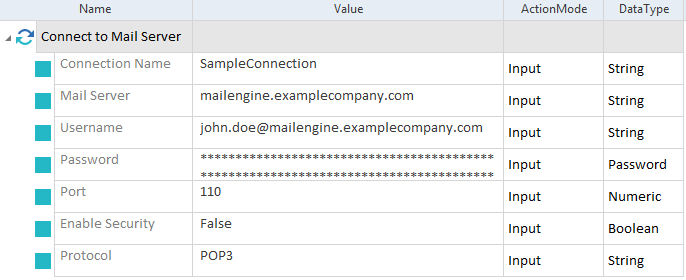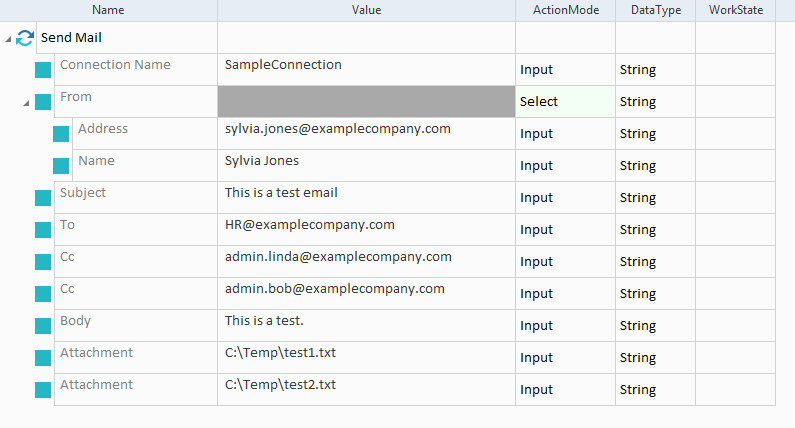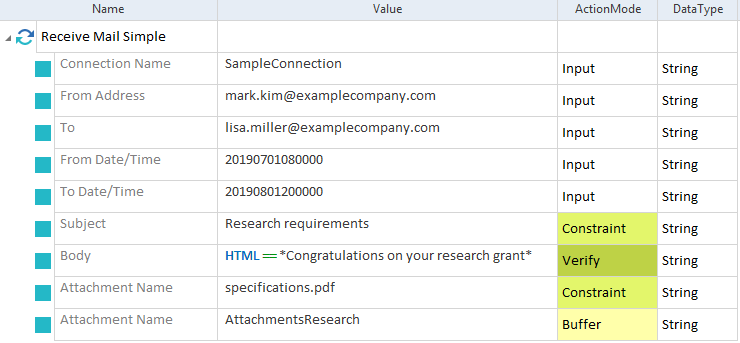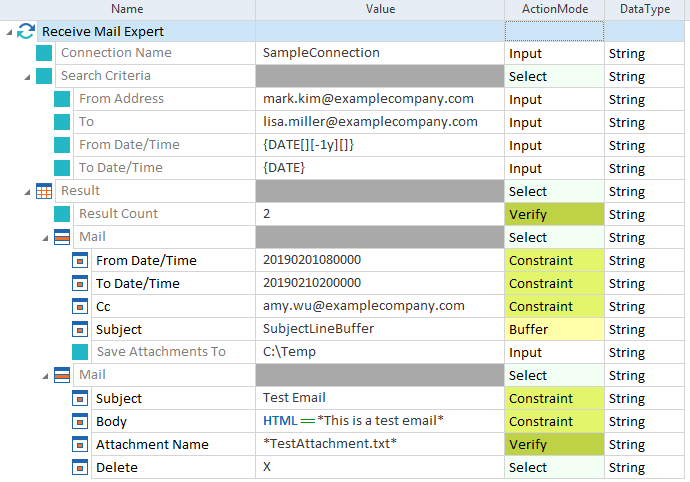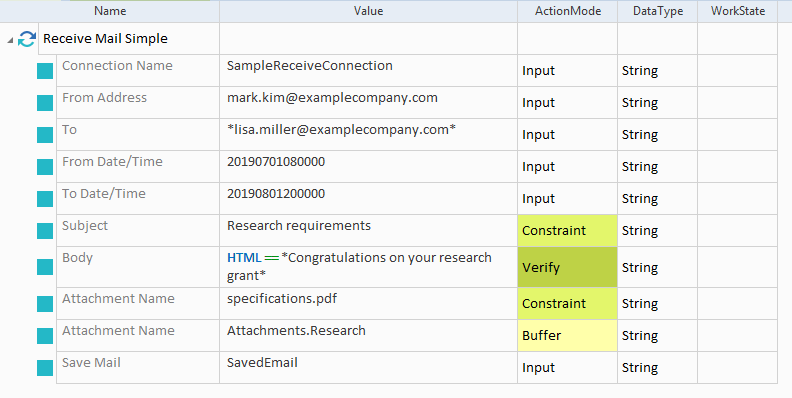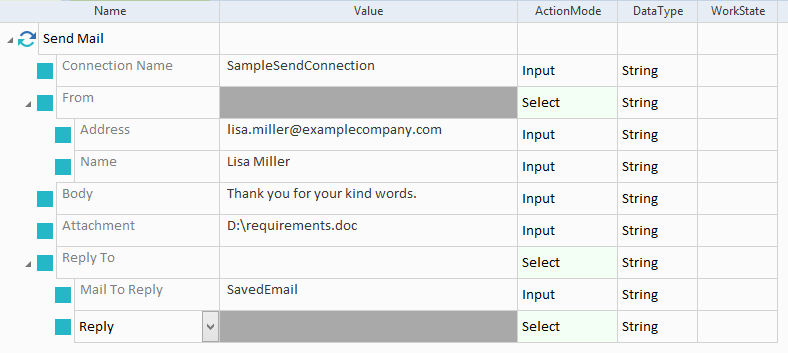Mail Modules
The folder TBox XEngines->Mail in the Standard subset contains Modules that perform specific tasks for the Mail Engine 3.0.
Connect to Mail Server
The Module Connect to Mail Server allows you to create or link an email server with which you test email features. This step is mandatory for all Mail Engine 3.0 TestCases.
The Module has the following ModuleAttributes:
|
ModuleAttribute |
Description |
|---|---|
|
Connection Name |
Specify a unique name for the mail server that you want to create or link. The Mail Engine 3.0 uses this connection name in later TestSteps to connect to the mail server. |
|
Mail Server |
IP address or FQDN (Fully Qualified Domain Name) of the mail server. |
|
Username |
User name of the account with which you access the mail server. |
|
Password |
Password of the specified user name. |
|
Port |
Port number through which you connect. Ensure the port is open and not blocked by the firewall. |
|
Enable Security |
Select whether you want to use a secure connection with SSL/TLS certificates during email operations. The available values are:
|
|
Protocol |
Specify the network protocol you want to use. The available values are:
|

|
In this example, you establish a connection with the name SampleConnection, which connects to the mail server mailengine.examplecompany.com. This connection has the following specifications:
Establish a connection to mailengine.examplecompany.com |
Send Mail
The Module Send Mail allows you to send and reply to email messages via Simple Mail Transfer Protocol (SMTP).
It has the following ModuleAttributes:
|
ModuleAttribute |
Description |
|---|---|
|
Connection Name |
Enter the name of the connection that you defined. |
|
From->Address |
Specify the email address of the sender. |
|
From->Name |
Specify the name of the sender. This ModuleAttribute is optional. |
|
Subject |
Specify the subject line. This ModuleAttribute is optional. |
|
To |
Specify a recipient. You can add multiple recipients. |
|
Cc |
Specify a copy recipient. You can add multiple recipients in separate module attributes. This ModuleAttribute is optional. |
|
Bcc |
Specify a blind copy recipient. You can add multiple recipients in separate module attributes. This ModuleAttribute is optional. |
|
Body |
Enter the message body. The body of the sent email uses HTML format. This ModuleAttribute is optional. |
|
Attachment |
Specify the full file path to the attachment. You can add multiple attachments in separate module attributes. This ModuleAttribute is optional. |
|
Reply To->Mail To Reply |
Name of the saved email. This ModuleAttribute is optional. |
|
Reply To->Reply Options |
Select one o the following options from the Reply Options drop-down menu:
This ModuleAttribute is optional. |

|
In this example, you send an email message with the following specifications:
Send an email |
Receive Mail Simple
The Module Receive Mail Simple allows you to check whether you received a specific, single email. This functionality supports POP3 or IMAP protocols only.
If you want to check the receipt of multiple emails, use the Module Receive Mail Expert.
The Module Receive Mail Simple has the following ModuleAttributes:
|
ModuleAttribute |
Description |
|---|---|
|
Connection Name |
Name of the connection that you defined. Use ActionMode Input. |
|
From Address |
Specify the email address of the sender. This ModuleAttribute is optional. |
|
From Name |
Specify the name of the sender. This ModuleAttribute is optional. |
|
To |
Specify a recipient. This ModuleAttribute is optional. |
|
Cc |
Specify a copy recipient. This ModuleAttribute is optional. |
|
From Date/Time |
Specify the start date and time of the search period. The Mail Engine 3.0 uses UTC time. Consequently, you need to enter the start time and date in UTC time. This ModuleAttribute is optional. |
|
To Date/Time |
Specify the end date and time of the search period. The Mail Engine 3.0 uses UTC time. Consequently, you need to enter the end time and date in UTC time. This ModuleAttribute is optional. |
|
Subject |
Specify the subject line. This ModuleAttribute is optional. |
|
Body |
Enter the message body. The default format in Mail Engine 3.0 is plain text. If Tosca doesn't return the expected results, select the HTML property to switch to html format. Use wildcards to ensure that the Mail Engine 3.0 only verifies the body text, not the HTML tags. This ModuleAttribute is optional. |
|
Attachment Name |
Specify the file name of the attachment. You can have multiple attachments. In the background, the Mail Engine 3.0 stores all attachment names as one string, separated by semicolons. If you want to verify whether a specific attachment exists, use leading and trailing wildcards. The wildcards ensure that the Mail Engine 3.0 only verifies the existence of the one attachment, not the entire string. For example, if you have several attachments, but only want to verify whether the attachment TestAttachment.txt exists, enter *TestAttachment.txt*. You can also buffer attachment names. However, you can only buffer the entire string, not individual attachment names. This ModuleAttribute is optional. |
|
Folder |
This functionality is supported by IMAP servers only. Specify the folder structure path, for example INBOX.TestFolder. The separator depends on the mail server that you use. Use ActionMode Input. The server settings determine the exact folder names, including lowercase and uppercase letters. This ModuleAttribute is optional. |
|
Save Attachment To |
Specify the path to the folder where you want to save the attachment. Use ActionMode Input. If your email contains several attachments, all of them are saved to this folder. If the folder already contains attachments with the same name, the Mail Engine 3.0 overwrites the existing files. This ModuleAttribute is optional. |
|
Save Mail |
Specify a unique name for the mail that you want to save. In the Send Mail module this can be used to send a reply message. |
You can use regular expressions and wildcards.
Use ActionModes
Unless otherwise specified in the descriptions of the ModuleAttributes in the table above, you can use the following ActionModes:
-
ActionMode Input to define base search criteria.
-
ActionMode Constraint to further narrow down the search of all emails that fit the base search criteria.
-
ActionMode Verify to verify data.
-
ActionMode Buffer to save data to a buffer.

|
In this example, you check whether you have received a specific, single email. To do so, you use the connection SampleConnection that you established earlier (see chapter "Connect to Mail Server"). The base search criteria are the following:
Out of all emails that fit these criteria, you are looking for the one that fulfills the following requirements:
Once the Mail Engine 3.0 has found the email, you want to perform the following actions:
Search for a specific email |
Receive Mail Expert
The Module Receive Mail Expert allows you to check whether you received specific emails. This functionality supports POP3 or IMAP protocols only.
If you want to check whether you received a specific, single email, use the Module Receive Mail Simple.
The Module Receive Mail Expert has the following ModuleAttributes:
|
ModuleAttribute |
Description |
|---|---|
|
Connection Name |
Name of the connection that you defined. Use ActionMode Input. |
|
Search criteria |
Read-only. |
|
Search criteria->From Address |
Specify the email address of the sender. This ModuleAttribute is optional. |
|
Search criteria->From Name |
Specify the name of the sender. This ModuleAttribute is optional. |
|
Search criteria->To |
Specify a recipient. This ModuleAttribute is optional. |
|
Search criteria->Cc |
Specify a copy recipient. This ModuleAttribute is optional. |
|
Search criteria->Subject |
Specify the subject line. This ModuleAttribute is optional. |
|
Search criteria->Attachment Name |
Specify the file name of the attachment. You can have multiple attachments. In the background, the Mail Engine 3.0 stores all attachment names as one string, separated by semicolons. If you want to verify whether a specific attachment exists, use leading and trailing wildcards. The wildcards ensure that the Mail Engine 3.0 only verifies the existence of the one attachment, not the entire string. For example, if you have several attachments, but only want to verify whether the attachment TestAttachment.txt exists, enter *TestAttachment.txt*. You can also buffer attachment names. However, you can only buffer the entire string, not individual attachment names. This ModuleAttribute is optional. |
|
Search criteria->Body |
Enter the message body. The default format in Mail Engine 3.0 is plain text. If Tosca doesn't return the expected results, select the HTML property to switch to html format. Use wildcards to ensure that the Mail Engine 3.0 only verifies the body text, not the HTML tags. This ModuleAttribute is optional. |
|
Search criteria->From Date/Time |
Specify the start date and time of the search period. The Mail Engine 3.0 uses UTC time. Consequently, you need to enter the start time and date in UTC time. This ModuleAttribute is optional. |
|
Search criteria->To Date/Time |
Specify the end date and time of the search period. The Mail Engine 3.0 uses UTC time. Consequently, you need to enter the end time and date in UTC time. This ModuleAttribute is optional. |
|
Search criteria->Folder |
This functionality is supported by IMAP servers only. Specify the folder structure path, for example INBOX.TestFolder. The separator depends on the mail server that you use. Use ActionMode Input. The server settings determine the exact folder names, including lowercase and uppercase letters. This ModuleAttribute is optional. |
|
Result |
Read-only. |
|
Result->ResultCount |
Verify the result count of the filter criteria that you specified, i.e. how many emails the specific filter produces. To do so, enter the expected number and use ActionMode Verify. |
|
Result->Mail |
Each Mail node under Result represents an individual email that you want to search for and test. You can search for and test multiple emails. To do so, create a separate node for each email and fill out the Mail Attributes. |
|
Result->Mail->Mail Attributes |
Specify further search criteria to narrow down the search. You can choose the following criteria from the Mail Attributes drop-down menu:
|
|
Result->Mail->Mail Operations |
You can select the following operations from the Mail Operations drop-down menu:
You can use one operation per email. Use ActionMode Select. |
|
Result->Mail->Save Attachments To |
Specify the path to the folder where you want to save the attachment. Use ActionMode Input. If your email contains several attachments, all of them are saved to this folder. If the folder already contains attachments with the same name, the Mail Engine 3.0 overwrites the existing files. This ModuleAttribute is optional. |
|
Result->Mail->Save Mail |
Specify a unique name for the mail that you want to save. In the Send Mail module this can be used to send a reply message. |
You can use regular expressions and wildcards.
Use ActionModes
Unless otherwise specified in the descriptions of the ModuleAttributes in the table above, you can use the following ActionModes:
-
ActionMode Input to define base search criteria.
-
ActionMode Constraint to further narrow down the search of all emails that fit the base search criteria.
-
ActionMode Verify to verify data.
-
ActionMode Buffer to save data to a buffer.

|
In this example, you check whether you have received specific emails. To do so, you use the connection SampleConnection that you established earlier (see chapter "Connect to Mail Server"). The base search criteria are the following:
Out of all emails that fit these criteria, you are looking for two specific emails. You also want to check that only two emails match all specified criteria. To do so, you verify the result count. Email 1 must fulfill the following requirements:
Furthermore, you want to perform the following actions on Email 1:
Email 2 must fulfill the following requirements:
Furthermore, you want to perform the following actions on Email 2:
Search for two specific emails |
Reply to an email
You can reply to an email that you received and saved with the Send Mail Module.
To do so, you have to populate all reply fields with valid values as shown in the example below. The Mail Engine populates the subject and address fields with values from the original email that you received. For the subject line, it adds the prefix Re: in front of the original email subject.
You can use the Body ModuleAttribute for the content of your reply email. You can also add new attachments. The reply email doesn't contain any attachments from the original email that you reply to.

|
In this example, you reply to an email message. First, you need to search for the email you want to reply to and save it. You have the following base search criteria:
Multiple emails fit these criteria, so you add the following criteria:
Once the Mail Engine 3.0 has found the email, you want to perform the following actions:
Search for a specific email and save it Now you can send the reply message::
Send a reply email |
